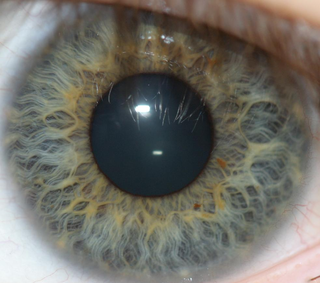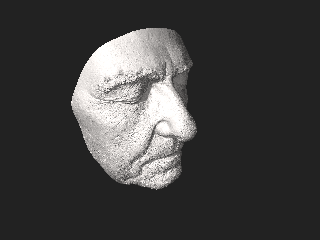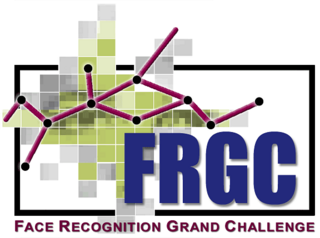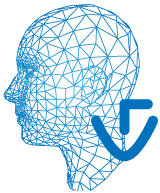
Multiple Biometric Grand Challenge (MBGC) is a biometric project. Its primary goal is to improve performance of face and iris recognition technology on both still and video imagery with a series of challenge problems and evaluation.

Multiple Biometric Grand Challenge (MBGC) is a biometric project. Its primary goal is to improve performance of face and iris recognition technology on both still and video imagery with a series of challenge problems and evaluation.
Over the last decade, numerous government and industry organizations have moved or are moving toward deploying automated biometric technologies to provide increased security for their systems and facilities. Six U.S. Government organizations recently sponsored the Face Recognition Grand Challenge (FRGC), Face Recognition Vendor Test (FRVT) 2006 and the Iris Challenge Evaluation (ICE) 2006. Results from the FRGC and FRVT 2006 documented two orders of magnitude improvement in the performance of face recognition under full-frontal, controlled conditions over the last 14 years. For the first time, ICE 2006 provided an independent assessment of multiple iris recognition algorithms on the same data set. However, further advances in these technologies are needed to meet the full range of operational requirements. Many of these requirements focus on biometric samples taken under less than ideal conditions, for example:
Building on the challenge problem and evaluation paradigm of FRGC, FRVT 2006, ICE 2005 and ICE 2006, the Multiple Biometric Grand Challenge (MBGC) will address these problem areas.
The primary goal of the MBGC is to investigate, test and improve performance of face and iris recognition technology on both still and video imagery through a series of challenge problems and evaluation. [1] The MBGC seeks to reach this goal through several technology development areas:
The MBGC will consist of a set of challenge problems designed to advance the current state of technology and conclude with a planned independent evaluation. Challenge problems will focus on three major areas:
These challenge problems will allow for fusion of face and iris at both the score level and the image level.
The Multiple Biometric Grand Challenge is based on previous challenges directed by Dr. P. Jonathon Phillips. Specifically the Facial Recognition Grand Challenge (FRGC) and the Iris Challenge Evaluation (ICE 2005). The programmatic process of a Challenge Problem is as follows. The Challenge Team designs the protocols, challenge problems, prepares challenge infrastructure, and composes the necessary data sets. Organizations then sign licenses to receive the data and begin to develop technology (mostly computer algorithms) in an attempt to solve the various challenges laid out by the Challenge Team. To advance and inform the various participants and interested parties the Team hosts workshops. The first workshop gives an overview of the challenge and introduces the first set of challenge problems (typically referred to as Version 1). The data sets are then released to participating organizations who develop their algorithms and submit self reported results back to the Challenge Team in the form of similarity matrices. The Team analyzes these results and then hosts another workshop. At the 2nd Workshop the Challenge Team reports the results from Challenge Version 1 and releases the Challenge Version 2. The cycle is repeated, finishing with a final workshop. At this stage the Participants are requested to submit not their self reported results, but the actual executables (or SDKs) to their algorithms. The Challenge Team then runs these algorithms through a battery of tests on large sequestered datasets. This phase ultimately determines the performance levels of the participant's algorithms. A final report is issued by the Team which is used by Industries and Governments to determine the actual state of the art in a given field and to provide participating organizations a basis for showing their performance within that field.
The Multiple Biometric Challenge Version 1 was released in April 2008. This initial set of challenge problems had the following goals.
The Version 1 series was separated into three distinct areas with various experiments under those areas.
Version 1 results were submitted in November 2008, and reported at the MBGC 2nd Workshop in December 2008.
The MBGC Challenge Version 2 was released in January 2009. Results were reported at a workshop in December 2009. [2]
The Multiple Biometric Evaluation (MBE) began in Summer 2009. The purpose of the MBE is to conduct an independent evaluation of the MBGC submissions on large sequestered data sets.
Computer vision tasks include methods for acquiring, processing, analyzing and understanding digital images, and extraction of high-dimensional data from the real world in order to produce numerical or symbolic information, e.g. in the forms of decisions. Understanding in this context means the transformation of visual images into descriptions of the world that make sense to thought processes and can elicit appropriate action. This image understanding can be seen as the disentangling of symbolic information from image data using models constructed with the aid of geometry, physics, statistics, and learning theory.
Biometrics are body measurements and calculations related to human characteristics. Biometric authentication is used in computer science as a form of identification and access control. It is also used to identify individuals in groups that are under surveillance.

Iris recognition is an automated method of biometric identification that uses mathematical pattern-recognition techniques on video images of one or both of the irises of an individual's eyes, whose complex patterns are unique, stable, and can be seen from some distance. The discriminating powers of all biometric technologies depend on the amount of entropy they are able to encode and use in matching. Iris recognition is exceptional in this regard, enabling the avoidance of "collisions" even in cross-comparisons across massive populations. Its major limitation is that image acquisition from distances greater than a meter or two, or without cooperation, can be very difficult. However, the technology is in development and iris recognition can be accomplished from even up to 10 meters away or in a live camera feed.

A facial recognition system is a technology potentially capable of matching a human face from a digital image or a video frame against a database of faces. Such a system is typically employed to authenticate users through ID verification services, and works by pinpointing and measuring facial features from a given image.

Three-dimensional face recognition is a modality of facial recognition methods in which the three-dimensional geometry of the human face is used. It has been shown that 3D face recognition methods can achieve significantly higher accuracy than their 2D counterparts, rivaling fingerprint recognition.
Multimodal interaction provides the user with multiple modes of interacting with a system. A multimodal interface provides several distinct tools for input and output of data.

The Intelligence Advanced Research Projects Activity (IARPA) is an organization within the Office of the Director of National Intelligence responsible for leading research to overcome difficult challenges relevant to the United States Intelligence Community. IARPA characterizes its mission as follows: "To envision and lead high-risk, high-payoff research that delivers innovative technology for future overwhelming intelligence advantage."

Anastasios (Tas) Venetsanopoulos was a professor of electrical and computer engineering at Toronto Metropolitan University in Toronto, Ontario and a professor emeritus with the Edward S. Rogers Department of Electrical and Computer Engineering at the University of Toronto. In October 2006, Venetsanopoulos joined what was then Ryerson University and served as the founding vice-president of research and innovation. His portfolio included oversight of the university's international activities, research ethics, Office of Research Services, and Office of Innovation and Commercialization. He retired from that position in 2010, but remained a distinguished advisor to the role. Tas Venetsanopoulos continued to actively supervise his research group at the University of Toronto, and was a highly sought-after consultant throughout his career.
VeriFace is an online service for remote identity verification of customers developed by Slovak company Rokan Biometrics. It aims to provide biometric identity verification and customer onboarding via facial recognition software.
The Facial Recognition Technology (FERET) program was a government-sponsored project that aimed to create a large, automatic face-recognition system for intelligence, security, and law enforcement purposes. The program began in 1993 under the combined leadership of Dr. Harry Wechsler at George Mason University (GMU) and Dr. Jonathan Phillips at the Army Research Laboratory (ARL) in Adelphi, Maryland and resulted in the development of the Facial Recognition Technology (FERET) database. The goal of the FERET program was to advance the field of face recognition technology by establishing a common database of facial imagery for researchers to use and setting a performance baseline for face-recognition algorithms.

The Face Recognition Grand Challenge (FRGC) was conducted from May 2004 until March 2006 to promote and advance face recognition technology. It succeeded the Face Recognition Vendor Test.

The Face Recognition Vendor Test (FRVT) was a series of large scale independent evaluations for face recognition systems realized by the National Institute of Standards and Technology in 2000, 2002, 2006, 2010, 2013 and 2017. Previous evaluations in the series were the Face Recognition Technology (FERET) evaluations in 1994, 1995 and 1996. The project is now in an Ongoing status with periodic reports, and continues to grow in scope. It now includes tests for Face-in-Video-Evaluation (FIVE), facial morphing detection, and testing for demographic effects.
The Iris Challenge Evaluation (ICE) were a series of events conducted and managed by the National Institute of Standards and Technology for projects on technology development and evaluation for iris recognition. Industry, academia, and research institutions from both in and outside the U.S. were allowed to participate.

Vein matching, also called vascular technology, is a technique of biometric identification through the analysis of the patterns of blood vessels visible from the surface of the skin. Though used by the Federal Bureau of Investigation and the Central Intelligence Agency, this method of identification is still in development and has not yet been universally adopted by crime labs as it is not considered as reliable as more established techniques, such as fingerprinting. However, it can be used in conjunction with existing forensic data in support of a conclusion.
In order to identify a person, a security system has to compare personal characteristics with a database. A scan of a person's iris, fingerprint, face, or other distinguishing feature is created, and a series of biometric points are drawn at key locations in the scan. For example, in the case of a facial scan, biometric points might be placed at the tip of each ear lobe and in the corners of both eyes. Measurements taken between all the points of a scan are compiled and result in a numerical "score". This score is unique for every individual, but it can quickly and easily be compared to any compiled scores of the facial scans in the database to determine if there is a match.
Eye vein verification is a method of biometric authentication that applies pattern-recognition techniques to video images of the veins in a user's eyes. The complex and random patterns are unique, and modern hardware and software can detect and differentiate those patterns at some distance from the eyes.

A biometric device is a security identification and authentication device. Such devices use automated methods of verifying or recognising the identity of a living person based on a physiological or behavioral characteristic. These characteristics include fingerprints, facial images, iris and voice recognition.
DeepFace is a deep learning facial recognition system created by a research group at Facebook. It identifies human faces in digital images. The program employs a nine-layer neural network with over 120 million connection weights and was trained on four million images uploaded by Facebook users. The Facebook Research team has stated that the DeepFace method reaches an accuracy of 97.35% ± 0.25% on Labeled Faces in the Wild (LFW) data set where human beings have 97.53%. This means that DeepFace is sometimes more successful than human beings. As a result of growing societal concerns Meta announced that it plans to shut down Facebook facial recognition system, deleting the face scan data of more than one billion users. This change will represent one of the largest shifts in facial recognition usage in the technology's history. Facebook planned to delete by December 2021 more than one billion facial recognition templates, which are digital scans of facial features. However, it did not plan to eliminate DeepFace which is the software that powers the facial recognition system. The company has also not ruled out incorporating facial recognition technology into future products, according to Meta spokesperson.

Visage SDK is a multi-platform software development kit (SDK) created by Visage Technologies AB. Visage SDK allows software programmers to build facial motion capture and eye tracking applications.

Neurotechnology is an algorithm and software development company founded in Vilnius, Lithuania in 1990.
![]() This article incorporates public domain material from NIST Multiple Biometric Grand Challenge. National Institute of Standards and Technology.
This article incorporates public domain material from NIST Multiple Biometric Grand Challenge. National Institute of Standards and Technology.